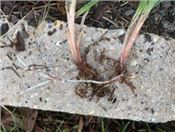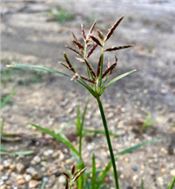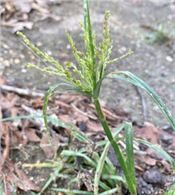Sedges Are Tough Nuts To Crack
BATON ROUGE, LA.
What is the No. 1 weed problem around the world? Answer: nutsedges, and they are a formidable foe! You have likely struggled with this weed in your lawn or garden beds. What makes sedges such a tough nut to crack?
There are two main types of nutsedges: yellow nutsedge (Cyperus esculentus) and purple nutsedge (Cyperus rotundus). Although commonly called nutsedge, the weeds don’t actually bear a nut, but they do produce small brown tubers that have a nutlike appearance.
There are several reasons why this weed is such a nuisance. First, they have a rapid upright growth, much faster than turfgrasses. They can cover a large area in a matter of days making them difficult to control. Secondly, sedges are a perennial weed, coming back year after year and making it more difficult to control than typical annual weeds.
Perhaps the main reason that sedges are so difficult to control is there’s more than one way for them to reproduce. Nutsedges spread in three ways: by underground tubers and by rhizomes that then produce more tubers. This is called vegetative growth, and it is extremely aggressive in sedges.
Nutsedges also produce seeds, but seeds often are not viable, and the plants rely on the underground tubers and rhizomes to reproduce rapidly. The tubers cause the most headaches in that they can remain dormant in the soil for three or more seasons. Most times when you pull the tops of plants, the tubers remain. It is not recommended that sedges be pulled by hand unless they are very small due to this fact.
Sedges can be positively identified in three ways. First, they have triangular, upright stems. Second, the leaf blade is also triangular.
Third, they produce flower heads that can be identified by their color of either purple or yellow. Purple nutsedge create spikes that are can be dark red or purple to a brown color. Yellow nutsedge spikes are yellow in color and can be gold or brown with many flowers.
Nutsedges are considered an indicator plant in that they thrive in poorly drained and compacted soils. You can often find them growing in disturbed areas with poor drainage in full sun. If you see nutsedge, this can be an indication that the surrounding soils are compacted or poorly drained.
The best way to control nutsedge is to be proactive. Ensure your turfgrass has vigorous growth with proper fertilization at appropriate cutting heights on a regular frequency. Once nutsedge is established, it is difficult to control. A healthy lawn with good drainage, loose soil and vigorously growing turfgrass is the best defense and competition to the nutsedge.
There also are chemical herbicides labeled for use on nutsedge with clever common names such as Sedgehammer and Sedge Ender. Be sure to read and follow the manufacturer’s label. For post-emergent herbicides that control both yellow and purple nutsedge, look for active ingredients halosulfuron, sulfosulfuron or imazaquin. For pre- emergent control of yellow nutsedge look for herbicides with the active ingredients metachlor and dimethenamid-p. Consult LSU AgCenter publication numbers 3624-LL and 3624-J for more information on herbicides and proper cultural practices such as cutting heights for specific turfgrasses. You can find these publications by searching for their numbers on www.LSUAgCenter.com.
Contact herbicides will need to be applied more than once because it will kill the leaves in the first spray but tubers and rhizomes will remain active if you only make a single application.
Pulling nutsedge is often ineffective and may make things worse. To effectively control, you must remove the nut growing 6 to 12 inches below the surface. Young, tender growth can be effectively removed before tubers begin to form, however. Additionally, cultivating or tilling nutgrass is also not recommended as it only redistributes the rhizomes along with the tubers.
However, some research has shown that purple nutsedge – not yellow nutsedge – can be controlled in the summertime by cultivating the affected area and withholding moisture and forcing the tubers to dry.
However, repeated tilling and drying are required, and this will not be effective in areas where other plants need irrigation.
Additionally, stressed tubers from hand weeding or treatment with contact herbicides that do not effectively kill the tuber itself can encourage more tuber growth and may cause more nutsedge production.
This is why nutsedges are the considered the No. 1 weed problem in the world. Keep your lawns healthy to help prevent nutsedge growth and stay proactive in your gardens. Pull young plants before tuber growth can occur. ∆



Photos by Heather Kirk-Ballard/LSU AgCenter
2. Nutsedges spread by underground tubers and rhizomes.
3.Purple nutsedge can be identified by dark purple to brown flowers and trianglular stems and leaf blades.
4. Yellow nutsedge can be identified by the light green to yellow flower spikes and triangular stems and leaf blades.